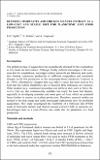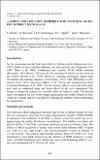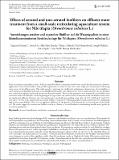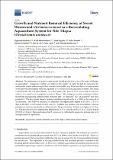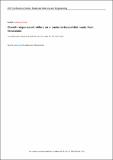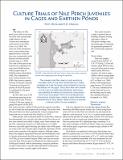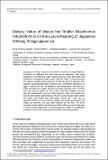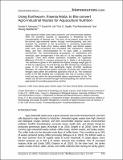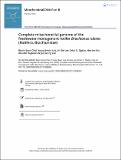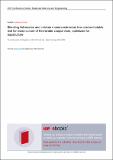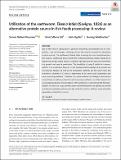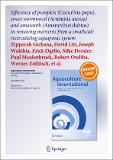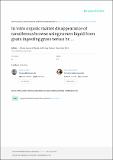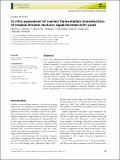Department of Fisheries and Natural Resources: Recent submissions
Now showing items 101-120 of 120
-
BLENDING FISHWASTES AND CHICKEN MANURE EXTRACT AS A LOW-COST AND STABLE DIET FOR PLANKTONIC LIVE FOOD PRODUCTION
(Ghent University, Belgium, 2017)The global increase of aquaculture has expanded the demand for the zooplankton as live foods for larviculture. Although freshly cultured microalgae is the common diet for zooplankton, microalgal culture protocols are ... -
A SIMPLE AND LOW-COST TECHNIQUE FOR CULTURING ROTIFERA WITHOUT MICROALGAE
(Ghent University, Belgium, 2017)So far, microalgae are the first choice diet for feeding rotifers (Maruyama et al., 1997), thanks to their excellent influence on rotifer growth rate (Hagiwara et al., 1997; Dhert et al., 2001; Yoshimatsu and Hossain, ... -
Composting fishwastes as low-cost and stable diet for culturing Brachionus rotundiformis Tschugunoff (Rotifera): Influence on water quality and microbiota
(Elsevier, 2018-02-03)The demand for the rotifers BRACHIONUS spp., which is considered indispensable for larviculture, has increased considerably in the tropical countries. Although freshly cultured microalga is the common rotifer diet, the ... -
The status of research on Lake Victoria fisheries: Historical and current data on fisheries and the lake environment
(AfricArXiv, 2019-09)Lake Victoria which is the second largest freshwater lake in the world supports a large population living around it through provision of food; fish and employment; both directly and indirectly. Due to its varied uses, human ... -
Effects of aerated and non-aerated biofilters on effluent water treatment from a small-scale recirculating aquaculture system for Nile tilapia (Oreochromis niloticus L.)
(Sciendo, 2020-04-21)Most recirculation aquaculture systems (RAS) use aerated biofilters to maintain suitable water quality for fish production. However, application of non-aerated biofilters may provide opportunities to lower aeration costs, ... -
Growth and Nutrient Removal Efficiency of Sweet Wormwood (Artemisia annua) in a Recirculating Aquaculture System for Nile Tilapia (Oreochromis niloticus)
(Multidisciplinary Digital Publishing Institute, 2019-05)The maintenance of optimal water quality for fish production is one of the major challenges in aquaculture. Aquaponic systems can improve the quality of water for fish by removing the undesirable wastes and in turn produce ... -
Growth response of rotifers on a bacterial-based diet made from fishwastes
(IOP Publishing, 2019-07)Fishwastes are potential low-cost diet sources for replacing microalgae, which is the popular diet for rotifers. Growth responses of rotifer were tested under different weights of the diet (i.e. 0.05, 0.1, 0.2 and 0.4 g/L), ... -
Culture Trials of Nile Perch Juveniles in Cages and Earthen Ponds
(2019-09)Fish were obtained from Asembo Bay, Dunga, Kendu Bay, Homa Bay and Mbita beaches around Lake Victoria using beach seines (< 10-mm mesh). Fish were sorted by size and stocked into hapa nets, each measuring 3 m× 3 m× 1 m, ... -
A review on the status of some major fish species in Lake Victoria and possible conservation strategies
(Lakes & Reservoirs: Science, Policy and Management for Sustainable Use., 2020-01-09)Lake Victoria, the second largest freshwater lake in the world, supports an enormous flora and fauna biomass, with a large human population around the Lake. The lake is a source of food (fish), water for domestic use and ... -
Earthworm, Eisenia fetida, bedding meal as potential cheap fishmeal replacement ingredient for semi-intensive farming of Nile Tilapia, Oreochromis niloticus
(Aquaculture Research, 2020-02-11)The study amalgamated earthworm and agro-industrial wastes through vermicomposting and then evaluated the potential of the bedding (mixture of Eisenia fetida and vermicompost) to replace fishmeal in semi-intensive farming ... -
Dietary Value of Waste-Fed Rotifer Brachionus rotundiformis on the Larval Rearing of Japanese Whiting Sillago japonica
(E3S Web of Conferences, 2020-02-12)Abstract. Live food resources are useful for larval fish rearing. However, production of sufficient live food resources is expensive. This study employed a cost-effective rotifer culture technique using fish waste diet ... -
Using Earthworm, Eisenia fetida, to Bio-convert Agro-industrial Wastes for Aquaculture Nutrition
(BioResources, 2020)Agro-industrial waster pose great economic and evironmental hazards, while the economic success of aquaculture is a threatened bu the unsustainabiloity o fishmeal use. The aim of the present study were to bio-convert ... -
Complete mitochondrial genome of the freshwater monogonont rotifer Brachionus rubens (Rotifera, Brachionidae)
(Informa Uk Limited, trading as Taylor & Francil Group, 2019-12-10)The two complete mitochondrial genomes were sequenced from the freshwater monogonont rotifer Brachionus rubens. The genome sequences were 12,041 bp and 13,793 bp in size, and the gene order and contents were identical to ... -
Blending fishwastes and chicken manure extract as low-cost and stable diet for mass culture of freshwater zooplankton, optimized for aquaculture
(IOP Publishing, 2019)This study investigated the feasibility of fishwastes and chicken manure extract (CME) as cheap diet for mass culture of freshwater zooplankton. CME and fishwastes as well as carbon source were used to make fishwaste ... -
Utilization of the earthworm, Eisenia fetida (Savigny, 1826) as an alternative protein source in fish feeds processing
(Aquaculture Research Wiley, 2018-11-27)Use of fish meal in aquaculture is gradually becoming unsustainable due to com‐ petition, cost and ecological challenges hence the need to expand the alternative protein sources. The earthworm, Eisenia fetida is among ... -
Efficiency of pumpkin (Cucurbita pepo), sweet wormwood (Artemisia annua) and amaranth (Amaranthus dubius) in removing nutrients from a smallscale recirculating aquaponic system
(Aquaculture International, 2019-08-28)In aquaponic systems, plants absorb dissolved nutrients from aquaculture wastewater for their growth. The removal of nutrients allows reuse of water and minimises wastewater discharge to the surrounding environment. This ... -
In vitro organic matter disappearance of tanniferous browse using rumen liquid from goats ingesting grass versus browse
(Taylor & Francis, 2013-12-01)In vitro organic matter disappearance (IVOMD) of African browse species often indicates artificially low nutritive value due to the presence of condensed tannins (CT). Diet of the rumen liquor donor may change this if ... -
In vitro assessment of ruminal fermentation characteristics of tropical browse mixtures supplemented with yeast
(Blackwell Publishing Ltd, 2012-03-01)An in vitro ruminal gas production study was conducted to assess the effect of yeast supplementation on rumen fermentation of tanniniferous tropical browse mixtures prepared by mixing Berchemia discolor with Acacia ... -
Statview for Windows Statview for Windows, 1999
(2012-03-01)

